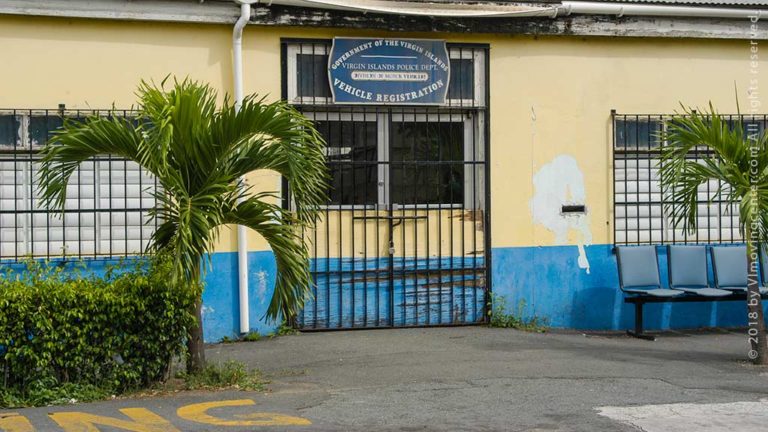
Your mainland license plates will not work here. Your car must be registered in the US Virgin Islands. Motorcycles go through the same registration and tax processes as cars.
Step 1. Customs
Clearing customs and paying duty is usually done at an office close to the shipping dock. The duty collected is based on country of origin on the car and is calculated using the book value or Bill of Sale, whichever is greater. The VIN number is used to determine origin: if the first digit is 1, 4 or 5 it is a U.S. car and there is a no duty owed. Vinu2019s starting with 2 or 3, there is a 6% duty. Vinu2019s starting with 6 or with a letter it is 3.5% duty. The U.S. Customs Office will accept personal checks, cash, certified checks and money order. You can call the Customs Office at (340) 714-1600 for more information.
Step 2. Road Tax
- You must get a Bill of Lading from the shipping agent when the car arrives in the USVI.
- Take the Bill of Lading to the Internal Revenue Office, and pay the 16 cents per pound road tax. This fee is accessed when you bring a car into the territory. Your title may have the weight on it; if it does that is what they will use. If it does not you can look up the weight on-line and print that page to show when paying the road tax. For more information call Internal Revenue office at (340) 714-9332. You can use cash, certified check or money order to pay this tax.
Step 3. Insurance
Insurance is required in the US Virgin Islands. You must get your vehicle insured before requesting a moving permit.
Compulsory Auto Liability Insurance is the law in the Virgin Islands; it requires that every registered vehicle have auto liability coverage. You must have auto insurance before you can request a moving permit and/or register your vehicle. When shopping around for auto insurance make sure the company is licensed to offer insurance in the U.S. Virgin Islands! The big name insurers common in the U.S. like Geico, All State and so on, do not exist in the U.S. Virgin Islands. If you are shipping your car you should check with your existing state-side insurance for information; and then contact local insurance companies in the U.S. Virgin Islands for quotes and coverage details. Once you have obtained a policy, get a certificate of insurance which provides details of your vehicle and coverage dates. A copy of your insurance card should be kept in your vehicle, a second copy is needed to register your vehicle. Failure to carry auto liability insurance may result in penalties such as fines for first offense; and fines and forfeiting right to operate a motor vehicle for not less than 30 days or more than 2 years from date of conviction.
Step 4. Moving Permit
Go to the Department of Motored Vehicles (DMV) to get a permit to move your vehicle from the dock. Moving permits are $5. The permit allows you to move a non-registered vehicle from one point to another and only between those two points. Usually the dock to the DMV. St. John residents would need to secure a moving permit to move their vehicle from the dock on St. Thomas to the car barge in Red Hook and then to the DMV on St. John to complete the inspection and registration process.
Step 5. Inspection
Take your vehicle to DMV to get your vehicle inspected. Bring with you, receipt that you paid the road tax, title or notarized letter indicating why you donu2019t have the title, proof of insurance and driveru2019s license. You do not need a Virgin Islands driveru2019s license, you can use your stateside driveru2019s license. A new resident has a 90 day grace period to get their Virgin Islands driveru2019s license. You may be asked to show your moving permit. There is a $10 inspection fee.
Inspection Process: The driver stays seated in the drivers seat unless asked to get out to open the trunk and show the spare tire. They will check windshield wipers, horn, lights, spare tire, turn signals, brake lights, breaks, tires, exhaust and muffler, mirrors, general condition of the caru2026 If you donu2019t pass inspection, the inspector will tell you why and give you a form showing what part you failed. You have to fix the problem and come back for inspection with the paper they gave you. If you fail inspection on a car that just entered the territory you will have to get a moving permit to get it to a garage to repair it and then another to bring it back to the DMV to complete inspection and registration.
Step 6. Registration/New Plates
Necessary paperwork for first time registrants are inspection form, receipt that you paid the road tax, title or notarized letter indicating why you donu2019t have the title, proof of insurance and driveru2019s license. You may be asked to show your moving permit. The cost of registration is based on the weight of the car. It can vary from $34 to $91 approximately. At the end of registration you will be given VI plates, a registration sticker for your windshield and a registration form. Plates and windshield sticker must be visible at all times.

